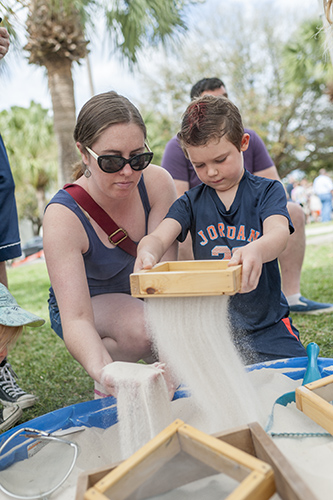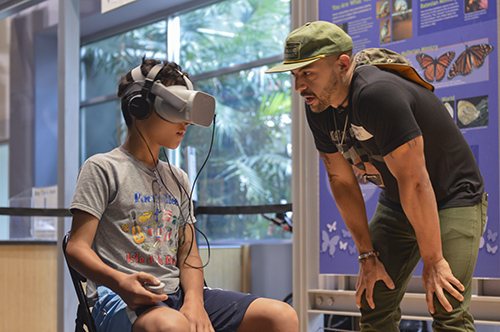GAINESVILLE, Fla. — The Florida Museum of Natural History and University of Florida department of geological sciences will teach visitors about the Earth beneath their feet at the annual ‘Can You Dig It?’ program on March 14 from 10 a.m. to 3 p.m.

The free event encourages guests to unearth facts about geology through various activities. Children, teens and adults of all ages are invited to explore how geological processes like volcanic eruptions and earthquakes work.
“For those of us putting on the event it is exciting and important because it gives us an opportunity to share our science and help people understand the wide range of important and exciting things that Earth scientists do,” said program coordinator Matthew Smith, a master lecturer and undergraduate adviser in the UF department of geological sciences.
The event activities allow visitors to sift through an augmented reality sandbox, dig for fossils, make an earthquake, help clean up a mock oil spill and watch a model volcano erupt. Two popular events are returning this year after a hiatus, allowing participants to identify meteorites and play with tectonic plate movement using Oreo cookies.

For the second year, representatives from the UF College of Journalism and Communications Media Effects and Technology Lab will give guests an opportunity to try their hand at ice core drilling through the use of virtual reality.
Food from Sublime Tacos and Hoggetowne Creamery will be available for purchase during the event.
‘Can You Dig It?’ is presented by the UF department of geological sciences and the Florida Museum in collaboration with the Gainesville Gem and Mineral Society. Additional financial support provided by Marvin and Cynthia Ivey.
For more information, visit www.floridamuseum.ufl.edu/canyoudigit or call 352-273-3062.
-30-
Writer: Gillian Sweeney, 352-273-2032, printern@flmnh.ufl.edu
Source: Matthew Smith, 352-392-2106, mcsmith@ufl.edu
Media contact: Paul Ramey, APR, 352-273-2054, pramey@flmnh.ufl.edu
Sample ‘Can You Dig It?’ Activities List
10 a.m. to 3 p.m., March 14, 2020
Florida Museum of Natural History
Augmented Reality Sandbox: Understanding topographic maps – This sandbox combines real sand with virtual reality to show how 2D topographic maps show the 3D shape of the land. Make your own surface in the sandbox and watch as the virtual reality projection mirrors your model. Then, make it rain in the sandbox and see how virtual water flows in your model.
Event Information Station and Passport Prizes – Grab a passport and collect stamps as you explore– then receive a prize for your completed passport!
Fossil Dig – Sift sand for fossils alongside Florida Museum paleontologists and sift for microfossils using screens and water.
Gainesville Gem and Mineral Society: Experience Rocks and Minerals – Explore rocks and minerals through touch, experiments and games.
Gainesville Gem and Mineral Society: Hobbies that Rock – Find out how hobbies such as collecting, rockhounding and lapidary (cutting or polishing gems) can be fun for the whole family.
Groundwater: Florida’s Precious Natural Resource – Investigate how groundwater flows through and shapes the subsurface while discovering Florida’s underground rivers. Explore what you can do to protect our drinking water supply.
Invertebrate Paleontology – Experience Florida’s many invertebrate fossils, big and small, with specimens and activities from the Florida Museum Invertebrate Paleontology Division.
Make Your Own Earthquake – Learn about how, why and where earthquakes happen, and then make your own earthquake to find out how you measure on the Richter scale.
Meteorites and Meteor-wrongs – Meteorites can and do strike the Earth. Check out these space rocks and see how they differ from other rocks found on Earth. Learn how to identify and distinguish real meteorites from look-a-likes.
Oil Spill and Cleanup – Investigate how chemistry is used to clean up these environmental catastrophes.
Oreo Plate Tectonics – Use these tasty treats to explore the process behind mountain formation and how the world changes over time.
Paleomagnetism – Rocks contain their own compasses, and they don’t always point north. See how scientists use Earth’s magnetism to reconstruct how the continents have moved through time.
The Power of Water: How the Land Gets its Shape – Use wave tanks and other interactive models to explore water’s power in shaping our ever-changing environment.
The Rock Cycle – Discover how rocks are continuously recycled on Earth into new rocks and learn about the different environments in which they form.
Rock Drilling – See how geologists use the drilling process to obtain core samples from hard rock as the first step in determining a past continent’s magnetic direction and location on Earth.
Secrets of Sand – Take an up-close look under a microscope to see the secrets of sand revealed.
Tools of a Geologist – Learn why geologists are the real “Inspector Gadgets” and bring your minerals and rocks to be identified.
VR Environmental Expeditions: Underwater and on the Ice – Rehabilitate oil slicked penguins and join an Antarctic research team studying climate change in three VR simulations hosted by the UF College of Journalism and Communications Media Effects and Technology Lab.
Volcanoes (periodic eruptions scheduled on the hour and half-hour starting at 10:30 a.m. until 2:30 p.m.) – Participate in ongoing interactive demonstrations and investigate why some volcanoes erupt explosively while others often do not, but watch out – ours is ready to blow.